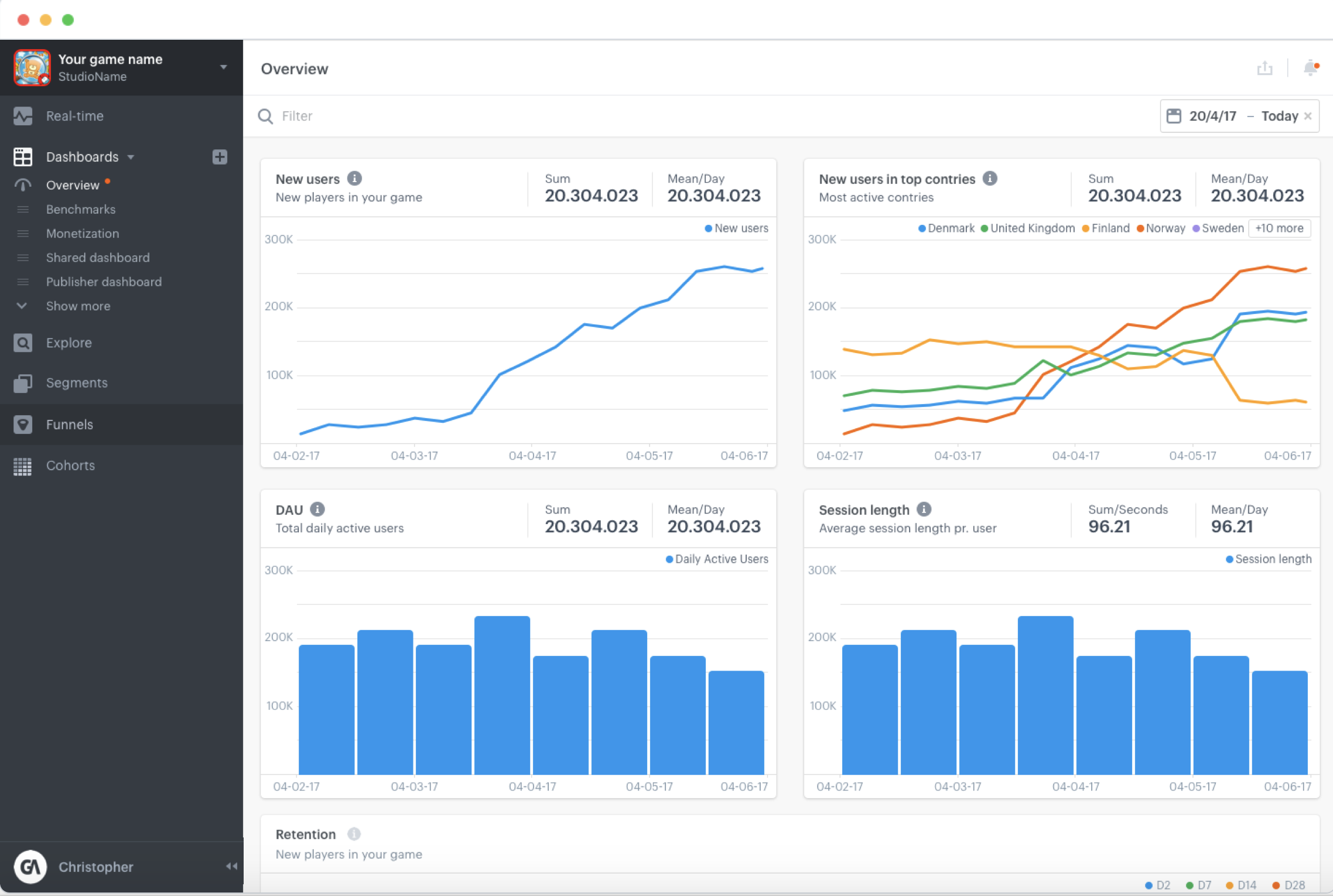In the fast-paced mobile gaming world, developers face the daunting challenge of capturing and retaining players’ attention amidst intense competition. To succeed, game designers must continuously improve their game’s design and performance. Thankfully, analytics has emerged as an invaluable ally in this pursuit. By harnessing the power of data, developers can gain profound insights into player behavior, preferences, and engagement patterns. In this blog post, we will delve into the dynamic realm of game analytics, exploring its impact on mobile game design and performance.
We will uncover compelling statistics and trends, examine practical analytics tools such as Unity Analytics, Google Analytics, and GameAnalytics, showcase case studies of successful games that have leveraged analytics, and present strategies for collecting and analyzing data to unlock the full potential of your competition!
Table of Contents
Game analytics serves as a compass, guiding developers toward success.
In the realm of mobile gaming, analytics plays a vital role in creating captivating and successful games. Collecting, measuring, and analyzing player data unravel the mysteries of player behavior. By employing analytics, developers gain a profound understanding of how players interact with their games, enabling them to make informed design decisions, optimize gameplay experiences, and enhance monetization strategies.
The primary objective of game analytics is to enhance the player experience. It achieves this by identifying pain points, improving game mechanics, and personalizing content to align with players’ preferences. By leveraging analytics, developers can monitor and track various metrics, including player progression, session length, retention rates, and revenue generation. These valuable insights empower developers to make data-driven decisions, refine gameplay, optimize in-game economies, and deliver tailored experiences that captivate players.
Follow the trends and be data-driven
To navigate the ever-evolving landscape of mobile gaming, developers must stay abreast of statistics and trends that shape player behavior. Understanding these trends is essential for creating games that resonate with players and generate revenue. For instance, studies reveal that the average mobile game session lasts approximately 8 minutes. This underscores the importance of capturing players’ attention and delivering engaging experiences quickly.
Developers must focus on creating compelling gameplay mechanics and intuitive user interfaces that captivate players from the very beginning.
Designing captivating in-game economies and offering appealing virtual goods can significantly impact the monetization potential of a game. Moreover, in-app purchases have emerged as a significant revenue generator in the mobile gaming industry.
Analytics plays a pivotal role in
- identifying purchasing patterns
- optimizing pricing strategies
- creating targeted offers,
leading to increased revenue generation.
Data-driven insights also help developers adapt to the changing preferences of mobile gamers. Developers can identify emerging trends by analyzing player data, such as new gameplay mechanics or popular genres. This knowledge empowers developers to stay ahead of the curve and tailor their games to meet players’ evolving expectations, resulting in heightened engagement and satisfaction.
Find the tool that works best for you
Numerous analytics tools are available to assist game developers in collecting and analyzing player data. Let’s explore three prominent tools widely used in the industry:
- Unity Analytics: Unity Analytics offers a comprehensive suite of features tailored specifically for game developers. Among its many offerings are real-time reporting, customizable dashboards, and player segmentation capabilities. Developers can track key metrics such as player progression, session length, and retention rates. Unity Analytics also facilitates A/B testing, enabling developers to experiment with different features or design choices and assess their impact on player engagement.

- Google Analytics for Firebase: Google Analytics for Firebase is a robust tool offering extensive tracking capabilities, making it a popular choice for mobile game developers. This tool provides valuable insights into user acquisition, retention, engagement, and monetization. With Firebase’s cloud-based infrastructure integration, developers can seamlessly collect and analyze data to better understand player behavior. They can track user actions within the game, such as level completion rates, in-app purchase conversion rates, and ad performance. The comprehensive reports and customizable dashboards empower developers to make data-driven decisions to optimize the game’s design, gameplay mechanics, and monetization strategies.

- GameAnalytics: GameAnalytics specializes in game-centric analytics, offering a range of features tailored to the specific needs of game development. It provides valuable insights into player behavior, progression, and monetization. Developers can track player retention rates, and revenue generation and analyze in-depth player interactions. The tool allows for cohort analysis, enabling developers to understand player behavior based on specific segments and identify patterns for targeted improvements. With GameAnalytics, developers can gain a holistic view of their game’s performance and make informed decisions to enhance player engagement and monetization strategies.

How do successful mobile games use analytics?
Numerous mobile games have harnessed the power of analytics to improve their design and performance significantly. Here’re some compelling case studies:
- “Crossy Road”: This popular mobile game used analytics to refine its gameplay mechanics. By analyzing player data, the developers discovered that players enjoyed short and addictive gameplay sessions. Armed with this insight, they refined the game’s core mechanics to create a more engaging experience. They also leveraged analytics to fine-tune the difficulty curve, ensuring that it provided an appropriate level of challenge without becoming frustrating. As a result, “Crossy Road” achieved remarkable success, garnering millions of downloads and generating significant revenue.
- “Candy Crush Saga”: Analytics played a pivotal role in the success of this addictive puzzle game. The developers utilized data analysis to optimize in-app purchases and level difficulty. They identified opportunities to enhance the game’s virtual economy by analyzing player behavior and spending patterns, resulting in increased player engagement and revenue. Additionally, they used analytics to balance the difficulty of levels, ensuring that players remained challenged yet motivated to progress. Through these data-driven design decisions, “Candy Crush Saga” became a global phenomenon, captivating millions of players and achieving immense financial success.
Strategies for Collecting and Analyzing Data
- Define Key Performance Indicators (KPIs): Identify the metrics and KPIs aligned with your game’s objectives. You can gather relevant data that aligns with your goals by focusing on specific KPIs. This could include player engagement, retention rates, in-app purchases, or level completion rates.
- Implement Analytics Tools: Integrate robust analytics tools, such as Unity Analytics, Google Analytics for Firebase, or GameAnalytics, into your game. These tools provide the infrastructure to collect and analyze player data effectively. Configure the tools to track relevant events, actions, and behaviors within the game.
- Ensure Privacy and Ethical Considerations: Prioritize player privacy and adhere to ethical data collection practices. Clearly communicate your data collection policies to players and obtain their consent where necessary. Implement appropriate security measures to protect player data.
- Conduct Segmentation and Cohort Analysis: Segment your player base based on relevant criteria such as demographics, play styles, or spending habits. You can gain deeper insights into player behavior and preferences by analyzing different player segments. Cohort analysis allows you to compare and contrast groups of players to understand how changes in the game impact player engagement and retention over time.
- Iterate and Experiment: Continuously analyze and interpret the data to uncover actionable insights. Experiment with different features, gameplay mechanics, or monetization strategies and measure their impact on player behavior
Final Thoughts
In the ever-evolving landscape of mobile game design, analytics has become an indispensable tool for developers seeking to create captivating experiences and drive success. By harnessing the power of data, developers can make informed decisions that optimize gameplay, enhance player engagement, and maximize revenue generation. The statistics and trends in mobile game analytics highlight the importance of understanding player behavior and preferences, and the case studies of successful games demonstrate the tangible benefits of leveraging analytics in game design.
Game analytics empowers developers to make data-driven decisions that elevate their games to new heights.



